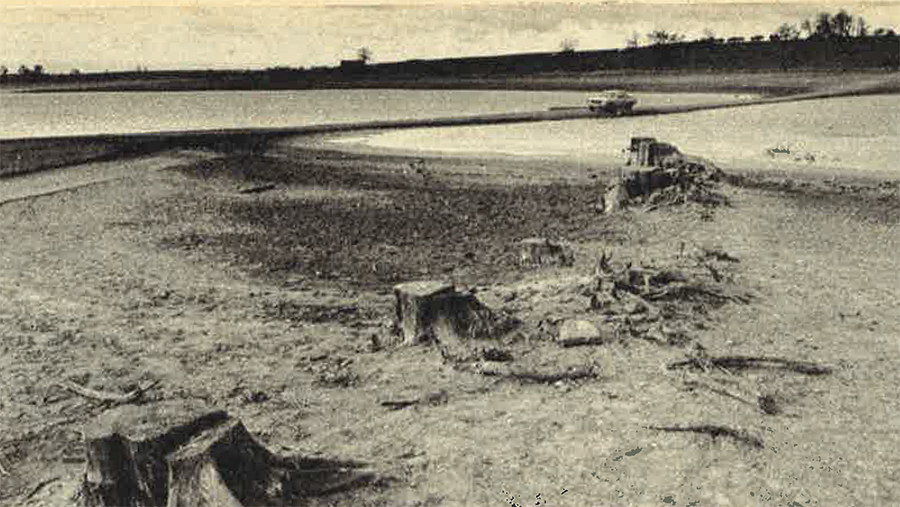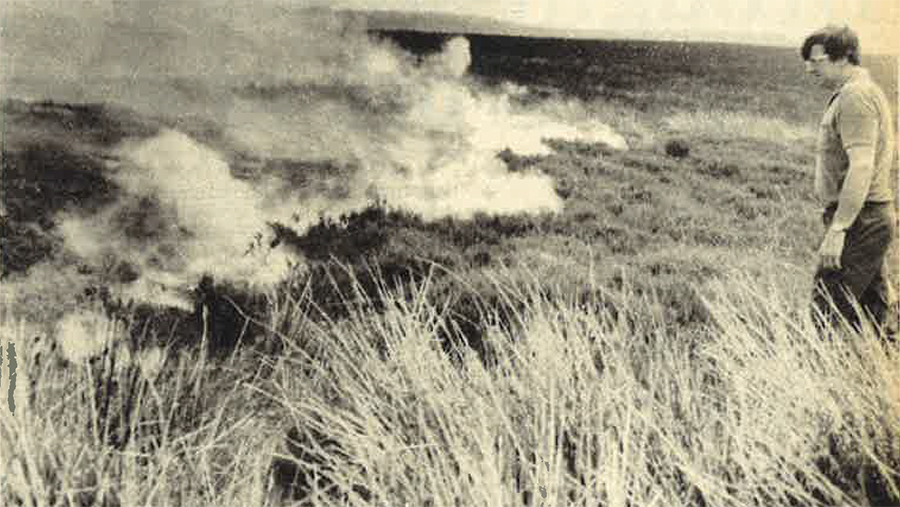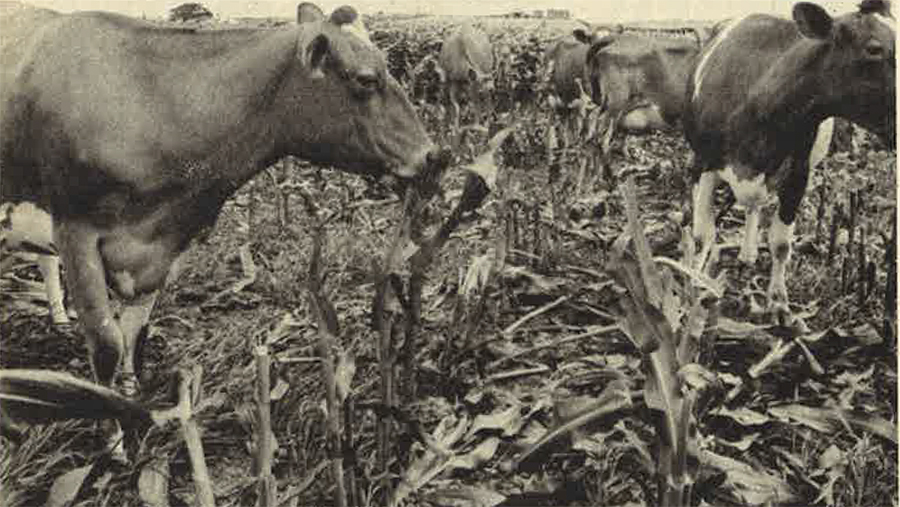How farmers coped in the drought of 1976
 Empty reservoir in 1976
Empty reservoir in 1976 With the dry weather continuing to affect much of the country and water levels falling, comparisons have inevitably been made with the “great” drought of 1976. But how bad was it back then?
A look back through Farmers Weekly issues provides some fascinating insights – though it immediately becomes clear that the problems of drought started way before the summer of 1976.
1975 was also a drought year, and that continued through the winter, leading to a serious water deficit even before the heatwave of 1976 started.
See also: Environment Agency steps up water abstraction inspections
As early as 9 April 1976, Farmers Weekly ran a lead news story under the headline “’Save water’ calls go out as reservoirs run dry”. “Much of England is in the grip of a drought that brings water rationing closer every day”, we reported.
Both arable and livestock farmers were advised by the then Ministry of Agriculture to expect rationing later in the year, and to keep private supplies well topped up.
North-south divide
The southern half of the country was worst affected, as in the same issue we reported that three weeks of heavy rain in Scotland had delayed drilling, prevented fertiliser spreading and hit lambing.
Elsewhere in England and Wales, however, the dry weather was proving a bonus for sheep farmers with eight months of ideal weather leading to a bumper lamb crop.
But predictions of tighter feed supplies and more mouths to feed were already driving up hay and straw prices – barley straw was quoted at £20/t, while grass keep was up 20% at £40/acre.
Other commodity prices were in the ascendency as a result of existing and predicted shortages, with ware potatoes hitting £250/t. “I will never see prices like this again in my lifetime,” predicted Hertfordshire grower Keith Hodge.
Later that month we reported on a Cotswolds dairy farmer whose cows were without water for 24 hours as his springs dried up and he had to install a stronger pump.
But Dorset farmer Anthony Hunt reported excellent grass growth, thanks to his choice of Italian ryegrass and a slurry irrigation system he installed two years previously.
| Now and then in numbers (England) | ||
| 1976 | 2018 | |
| Rainfall in June | 17.2mm | 15mm |
| Daily max temperature | 22C | 21.1C |
| Hottest day on record | 38.5C on 10 August 2003 | |
Heat continues
The hot weather continued through May and into June, with Bedfordshire farmer Tony Burton cutting his first hay on 22 May – several weeks ahead of normal.
The continuing hot spell also brought with it an increased disease risk for growing crops, and in the 18 June issue we ran an article “Aphid blitz raises wheat yield fears”, covering the rapid build-up of cereal aphids in the South East and East Anglia.
This threatened to cut yields by 20% and some farmers resorted to aerial spraying with helicopters to try to check the problem.
John White of merchant Kenneth Wilson described a “mad rush to get crops sprayed”, with “fantastic demand” for aerial application.
Farmers Weekly’s coverage of the drought really moved into overdrive in July and August. The Editor’s Diary of 9 July spoke of increasing farmer concern at the Royal Show at Stoneleigh, epitomised by the death of two pigs from heat exhaustion.
“I heard many stories of parched pastures and prematurely ripening corn from the farming visitors who sought shelter and sympathy on our stand,” wrote editor Travers Legge.
Cereal seed producers were already reporting a 20% drop in availability, while herbage seed was coming in at less than half its normal yield. “Demand for seed is abnormally high, as farmers order to re-seed failed spring sowings,” we reported.
Meanwhile, Norfolk sheep farmer Patricia Russell was forced to sell off some of the flock she had spent seven years building up due to the “desperate” grazing situation. Norfolk had had its driest June for more than a century.
Fire risk
Our 16 July issue also focused on a spate of field fires, especially in Wales. The Boden family fought a fire on their farm for three days, with Ned Boden losing a stone in weight and becoming seriously ill with smoke poisoning.
More than 80% of his 170-acre hill farm was destroyed and he was forced to sell his lambs as stores.

Welsh farmers were angered by the lack of help from the fire service or the army, which, they said, had “put trees before sheep”.
But at least farmers were told by planning minister John Silkin they would be prioritised should water rationing come in, as he introduced the government’s Drought Bill on 14 July, giving authorities the right to ban the use of water in swimming pools and car washes.
Anglia, Wessex, the South West, Wales and Yorkshire were identified as the worst-hit areas, but beyond these regions farmers were faring somewhat better, with grain merchants suggesting the total UK crop could still reach 13.8m tonnes, the same as in 1975.
While winter barley was coming off at less than 1t/ha in the Fens, Scottish growers were seeing spring barley yielding more than 4t/ha. Malting barley was trading at almost £85/t ex-farm, compared with £55/t the year before.
Dairy challenge
For dairy farmers, the drought was proving a huge challenge. One farmer lost his cooling system overnight and, by the next day, his milk was well on the way to becoming butter.
North East dairy farmer Colin Frank was forced to start strip-grazing his maize in late July owing to the lack of grass, as his Guernsey cows threatened to dry off early.

Meanwhile, farm contractors in the south of the country were reported to be laying off staff as drainage work dried up. In the Scottish borders, however, a grant-funded flood protection scheme for 20,000 acres beside the River Leet was nearing completion.
Scottish farmers were also engaged in a lucrative export trade in meadow hay with the Netherlands. “The fodder shortage in Holland is severe, while there are ample supplies in the Perth and Stirling areas,” said local dealer Stanley Johnston.
Irrigation ban
Moving into August, arable farmers in the East had already accepted a voluntary ban on irrigating their crops. The new Drought Act, however, gave water authorities the right to impose strict rationing, while farmers were told not to burn straw or stubble, but to incorporate it with the cultivator.
Dairy farmers in the South West were also reaching crisis point, with the Milk Marketing Board using bulk tankers to deliver water to some farms.
Dorset dairy farmer Gerald House told Farmers Weekly he had had only a 1/4in of rain since early March, a second cut of silage had been impossible and lost summer milk production from 150 pedigree Friesians has cost him £6,000.
In Derbyshire, meanwhile, there had been just one shower in 10 weeks and dairy farmers were culling hard to contain feed costs as milk output fell. “There is no room for passengers,” said NFU county milk chairman Bill Brown. At least they were making good money, at about £300 for well-fleshed animals.
Welsh sheep producers were also up against it. Sheep dipping was abandoned on many farms by mid-August, with the NFU asking for special dispensation for farmers to be able to sell their animals as “undipped”, even though this would get lower prices.
ADAS divisional drainage officer in Gwent and Glamorgan, C Griffiths, said the situation was at crisis point, with streams and ponds empty, springs drying up for the first time in living memory and mains supplies being cut for 12 hours a day.
However, farmers were dissuaded from re-seeding scorched plots, told by ADAS that “parched pastures will recover when the rain comes”.
Relief
And then the rain did come – almost inevitably, following the appointment of MP Denis Howell as the UK’s first “drought minister” and the establishment of a “water emergency committee”.
In the issue of 3 September, Farmers Weekly described the conditions at our Easton Lodge Farm in Cambridgeshire, where the heavens had opened over the weekend of 28/29 August.
“After weeks of burning sunshine, which has shrivelled our budgeted profit by more than £20,000, 3.57 inches of rain fell in three days.” That still only took the annual total to 13 inches – about 42% less than in an average year.
While it was too late for the cereal harvest, the soaking was good for the sugar beet. “It should also chit some kale seeds, which have lain dormant in the ground since mid-summer – if the birds haven’t had them.”
Of course, the legacy of the drought was felt for many months to come, especially for livestock farmers, who faced crippling bills to keep their animals fed during the winter.
The potato crop was decimated, vegetable crops were a disaster and the UK was faced with the cost of importing an extra million tonnes of grain to make good the national shortfall.
Meanwhile, the Labour government resisted impassioned calls for a devaluation of the “green pound” (used to convert European support prices into sterling) for fears it would push up the price of food and drive inflation.
